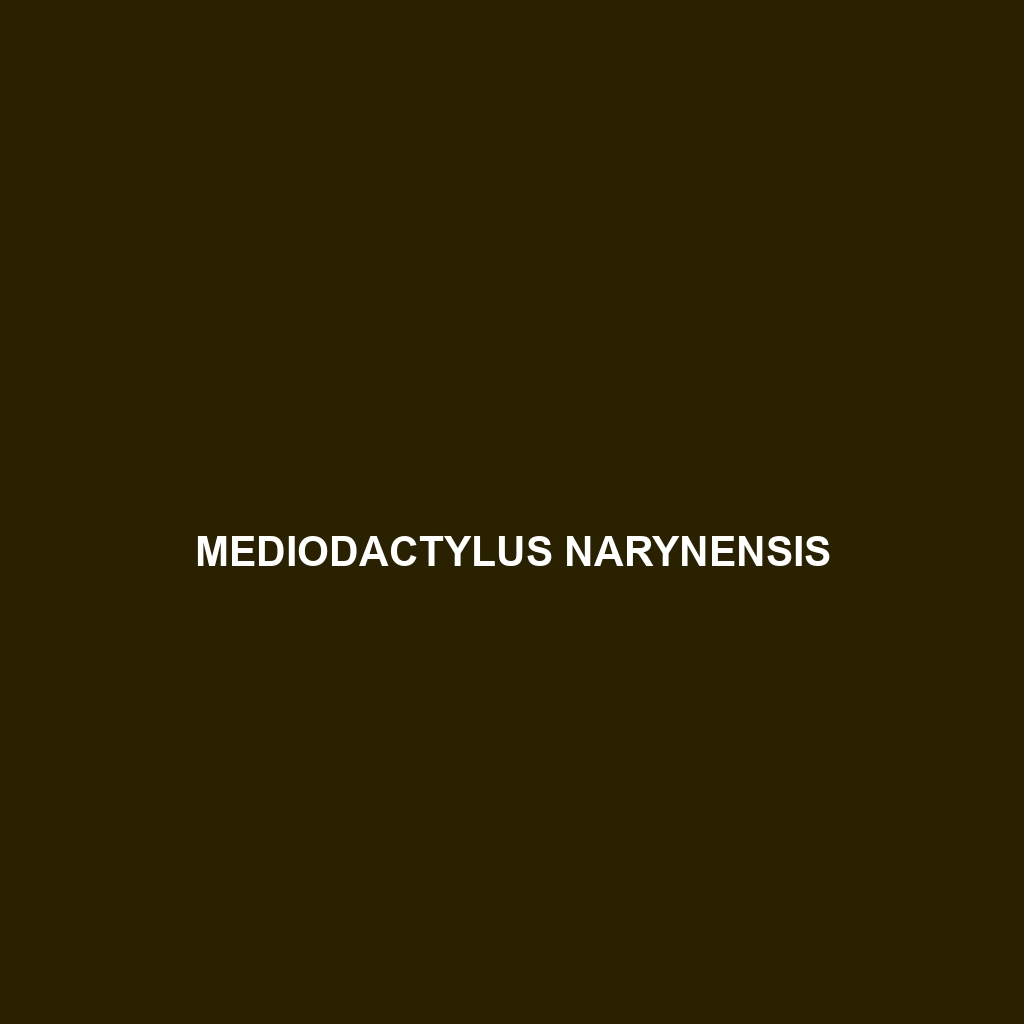Common Name
Mediodactylus narynensis
Scientific Name
Mediodactylus narynensis
Habitat
Mediodactylus narynensis is primarily found in the mountainous regions of Central Asia, particularly within the Naryn region of Kyrgyzstan. This species thrives in rocky outcrops and dry, rocky slopes characterized by temperate forests, where slight humidity and ample vegetation provide a suitable environment. The climate in this habitat varies, with cold winters and mild summers, making it a significant ecological niche in the region. The mix of forests and open shrubland contributes to a balance of both moisture and sunlight, which is essential for their survival.
Physical Characteristics
Physically, Mediodactylus narynensis is a distinguished species within the gecko family, measuring approximately 12-15 cm in length. Its skin exhibits a unique coloration that ranges from earthy browns and grays to lighter hues with patterns that aid in camouflage against rocky terrains. Notably, individuals possess a flattened body shape and elongated limbs, which enhance their ability to navigate rocky surfaces effortlessly. Their most striking feature includes large, adhesive toe pads that enable them to scale vertical surfaces with agility, an adaptation crucial for escaping predators and hunting for food.
Behavior
In terms of behavior, Mediodactylus narynensis is primarily nocturnal. This nocturnal nature allows them to avoid the daytime predators and to hunt more effectively during the cooler nighttime hours. These geckos exhibit interesting social interactions, often engaging in territorial displays and vocalizations during the mating season. Their mating rituals typically involve intricate movements and tactile communication. Additionally, they are known to utilize their ability to change colors slightly, which is believed to play a role in both camouflage and communication among species.
Diet
The diet of Mediodactylus narynensis consists mainly of small insects, making them insectivores. Their primary food sources include crickets, moths, and small beetles, which they adeptly hunt using their keen eyesight and quick reflexes. These geckos have developed a unique feeding strategy that typically involves ambush techniques, allowing them to consume their prey with minimal effort. Their specialized digestive system enables them to derive maximum nutrients from their food sources, contributing to their overall health and energy levels.
Reproduction
The reproductive cycle of Mediodactylus narynensis is fascinating. Mating usually occurs in late spring, with females laying clutches of 1-2 eggs in hidden crevices to protect them from predation. The gestation period for these eggs is approximately 60-90 days, after which the hatchlings emerge fully formed and independent. Parental care is minimal, as the young are capable of self-reliance from the moment they hatch. This strategy helps to reduce the burden on the parents while ensuring that the young have adapted to their environment right from the start.
Conservation Status
As of the latest evaluations, Mediodactylus narynensis is classified as a species of ‘Least Concern’ by the International Union for Conservation of Nature (IUCN). However, like many species within its habitat, it faces threats such as habitat loss due to urban development and climate change. Conservation efforts focus on habitat preservation and the establishment of protected areas within its native range, which are vital for maintaining healthy populations and ensuring the species’ longevity.
Interesting Facts
One intriguing fact about Mediodactylus narynensis is its ability to regenerate its tail after losing it due to predation—a prevalent survival tactic among geckos. This adaptation not only provides a chance at survival but also helps in swiftly evading predators. Moreover, the species is known for its distinctive calls, which can be heard during mating seasons, contributing to the rich soundscape of its natural habitat.
Role in Ecosystem
Mediodactylus narynensis plays a crucial role within its ecosystem as both a predator and prey. By controlling insect populations, it indirectly contributes to the health of plant life, as many insects are known to be herbivores that can harm vegetation. Additionally, as a prey species, they provide nourishment for larger predators, helping to maintain the balance of the food web. The gecko’s presence in its niche is indicative of a healthy ecosystem, making it essential for ecological studies and conservation efforts.
